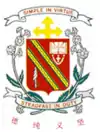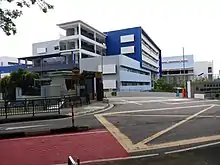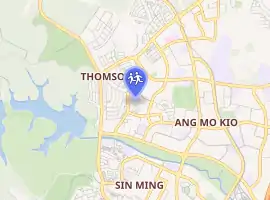CHIJ Saint Nicholas Girls' School
CHIJ St. Nicholas Girls' School (SNGS) is an all-girls Catholic primary and secondary school in Ang Mo Kio, Singapore. The school is one of 11 Convent of the Holy Infant Jesus (CHIJ) schools in Singapore. The school is one of the designated Special Assistance Plan (SAP) schools.
| CHIJ St. Nicholas Girls' School 圣尼各拉女校 Sekolah Perempuan St. Nicholas | |
|---|---|
 | |
 | |
| Address | |

| |
501 Ang Mo Kio Street 13 | |
| Coordinates | 1.3737°N 103.8343°E |
| Information | |
| Type | Government-aided Autonomous Special Assistance Plan |
| Motto | 娴雅少女,坚毅巾帼,仁爱领袖 (Girls of grace, women of strength, leaders with heart) |
| Established | 16 January 1933 |
| Session | Single session |
| School code | 7118 |
| Principal | Mrs Fiona Tan |
| Gender | Female |
| Enrolment | Approx. 3,000 |
| Colour(s) | Blue White |
| Affiliations | Eunoia Junior College and Catholic Junior College |
| Website | chijstnicholasgirls |
History
Early History
Saint Nicholas Girls' School was established by the Sisters of the Infant Jesus near the Town Convent at Victoria Street in Singapore on 16 January 1933 as a Chinese-medium primary school for girls. The school began with an enrolment of 40 pupils in two classes, Primary One and Primary Two. At that time the entire teaching staff consisted of only two people, the principal who taught English, and another teacher who served as a Mandarin instructor.[1] At that time, the then-principal Sister Francoise Lee felt the need to cater to Chinese Catholic girls.[2] She pushed for the expansion of the Town Convent to include a Chinese school. That school was built on the former building complex of Hotel van Wijk, run by missionaries to provide education for daughters of Chinese-speaking families, including disadvantaged families and wealthy Chinese merchants alike.[3] The decision to purchase Hotel van Wijk was in part a preventive measure against moral corruption. The former building complex was a hotbed for prostitution activities, thus the purchase would indirectly reduce such influence on the girls living in the Convent.[4] Sister Francoise led a fund raising to make the purchase possible. However, the English section of the Convent occupied the new building, while the Chinese section was relocated to the old buildings, citing reasons of a larger English population needing more space.[5]In 1941, the school expanded into a full school.
World War 2 and Japanese Occupation
During the war, the convent complex became a refuge for many, serving as an air raid shelter to safeguard the orphans, the sisters and some Carmelite nuns and the charges of the Good Shepherd Sisters. Many unfortunates, such as the poor, sick and handicapped were also sent to the convent to be cared for. One of the school’s buildings eventually became a shelter for as many as they could house.[6] During the Japanese Occupation of Singapore, it was known as Victoria Street Girls' School until 1945. During this period, the Japanese paid for the wages of the sisters and were responsible for necessities in the Convent. The European nuns had to wear armbands to show they were not British, and were required to learn Japanese and to teach a Japanese curriculum.[7] The Japanese did, however, treat the sisters with civility, and those living on the complex were allowed to do so in relative peace during the Occupation, as long as they complied with the Japanese governmental system.[8] Despite this, the convent experienced a decline in students, having no more than 200 students.[9] After the war in 1964, the school was separated into primary and secondary sections.
Attainment of SAP Status
St. Nicholas Girls School faced an enrollment crisis in the late 60s to the 70s as the Government was emphasizing English as the main medium of instruction over Mandarin, and thus many parents were pulling away from St. Nicholas when they realized it was a Mandarin-only school. Mdm Lee Poh See, the second principal of the school, played an integral role in rebranding the school as a bilingual institution in the late 60s to the early 70s, purchasing English textbooks en masse to supplement the then-dominantly Mandarin education of the students. This was done in an effort to appeal to parents who were seeking English-medium schools, whilst still retaining its Chinese roots. This move paid dividends in 1979 when St. Nicholas received Special Assistance Plan (SAP) status under the new long-term government initiative to preserve the best Chinese-stream schools as bilingual schools to nurture effectively bilingual students inculcated with traditional Chinese values. Under this scheme, the school offers both the English and Chinese languages as first languages to Special Stream students. The already strong bilingual culture of the school thus allowed it to adapt seamlessly to the SAP scheme, bringing it out of its precarious situation and giving it a new shot at prominence.[10] Also in that year, a pre-primary section was established.
Relocation to Toa Payoh
By 1980, the Victoria Street premises could no longer hold the whole school and some classes had to move out. They were temporarily held at the former Tao Nan School building at Armenian Street and the former Raffles Girls' Primary School at Queen Street.
In 1982, St. Nicholas Girls' School was provisionally relocated to Toa Payoh Campus and moved to the current site in Ang Mo kio in 1985 when the site was completed. During this time, CHIJ Toa Payoh was set up and officially opened on 17 August 1985. The school remained at the current Toa Payoh Campus until today.[11]
New campus in Ang Mo Kio
On 23 August 1986, the new campus at Ang Mo Kio Street 13 was declared open by Dr. Tony Tan Keng Yam, then Minister for Education.[12][13]
Renaming as CHIJ St. Nicholas Girls' School
In 1992, St. Nicholas Girls' School was renamed "CHIJ St. Nicholas Girls' School". The school was granted autonomous status by Ministry of Education in 1995 for recognition in value added academic performances.[14]
In January 2010, the Primary section was temporarily relocated to the former Kebun Baru Primary School site at 6, Ang Mo Kio Avenue 2, and the Secondary section moved to the former First Toa Payoh Secondary School site at 430, Lorong 1 Toa Payoh, while waiting for completion of the school's renovation under the PRIME programme (Programme for Rebuilding and Improving Existing Schools).[15] Finally, in 2013, CHIJ St Nicholas Girls' School finished its rebuilding and was declared open by Prime Minister Lee Hsien Loong.
In 2012, CHIJ St Nicholas Girls' School topped the O-level examinations for the 4th consecutive time.[16]
In 2013, CHIJ St Nicholas Girls’ School introduced the Integrated Programme (IP) in collaboration with Catholic High School and Singapore Chinese Girls’ School. The schools are designated a new junior college, Eunoia Junior College, to cater for the programme.[17][18]
In 2018, CHIJ St Nicholas Girls' School introduced the return of a popular canteen stall from the old Convent. It made The Straits Times for the nostalgia invoked in the alumni.[19]
Principals
| Name of Principal | Years Served |
|---|---|
| Sister Francoise Lee | 1940–1971 |
| Mdm. Lee Poh See | 1972–2000 |
| Ms. Helen Choo Chieh Chen | 2001–2006 |
| Mdm. Chan Wan Siong | 2006–2011 |
| Mrs Tan Wai Lan | 2012–2016 |
| Mrs Fiona Tan Su Ling | 2017–present |
Academic information
CHS-SNGS-SCGS Joint Integrated Programme
CHIJ St Nicholas Girls’ School jointly offers the Integrated Programme (IP) in collaboration with Catholic High School, Singapore Chinese Girls’ School and Eunoia Junior College from 2013. Under the programme, students may skip the Singapore-Cambridge GCE Ordinary Level examination in the respective schools, and complete Year 5 & 6 of pre-university education in Eunoia Junior College leading to the Singapore-Cambridge GCE Advanced Level examination.[17][18]
As a dual-track school, a 4-year Secondary Special/Express course is offered alongside the Integrated Programme.
Notable alumni
Entertainment
- Rebecca Lim: Actress, Mediacorp; Best Actress Asian Television Awards 2010, Best Actress Star Awards 2015 and 2018, TOP 10 female artists Star Award 2012- 2019, Runner-up Miss Singapore Universe 2005
- Sharon Au: Actress and presenter, Mediacorp; lead of styleXstyle
- Michelle Chong: Actress and presenter, Mediacorp; Founder of Left Profile
- Tanya Chua: Mandopop singer-songwriter; Record three-time winner of Best Mandarin Female Singer; Recipient, Golden Melody Awards
- Diana Ser: Actress and presenter; Nominated for Best Current Affairs Presenter, Asian Television Awards, 2004
- Lynn Tan: Winner, Miss Singapore Universe, 2012
- Charmaine Yee: Deejay, SPH Radio Kiss 92FM
Sports
- Ng Xuan Hui: Former national sailor
Politics and government
- Hazel Poa: Non-constituency Member of Parliament, Progress Singapore Party; former Secretary-General, National Solidarity Party
- Koh Juat Jong: Solicitor-General, Singapore; President's Scholar
- Sun Xueling: Member of Parliament, People's Action Party
- He Ting Ru: Member of Parliament, Workers' Party
Business
- Cheryl Koh: owner of Tarte by Cheryl Koh; Asia's Best Pastry Chef 2016
External links
References
- "Tony Tan Speech excerpt" (PDF). www.nas.gov.sg. Retrieved 5 March 2019.
- "E-Book". www.nas.gov.sg. Retrieved 25 January 2019.
- "St. Nicholas Girls' School at Victoria Street, between 1949 and 1980 – BookSG – National Library Board, Singapore". eresources.nlb.gov.sg. Retrieved 8 November 2016.
- Hudd, Sandra (17 June 2016). The Site of the Convent of the Holy Infant Jesus in Singapore: Entwined Histories of a Colonial Convent and a Nation, 1854–2015. Lexington Books. ISBN 9781498524124.
- "E-Book". www.nas.gov.sg. Retrieved 25 January 2019.
- "CHIJ during WW2". history.catholic.sg. Archived from the original on 23 March 2019. Retrieved 5 March 2019.
- "CHIJ during Japanese Occupation". www.straitstimes.com. Retrieved 5 March 2019.
- "CHIJ during Japanese Occupation". history.catholic.sg. Archived from the original on 23 March 2019. Retrieved 5 March 2019.
- "E-Book". www.nas.gov.sg. Retrieved 25 January 2019.
- "When the Bell Rings: CHIJ St Nicholas". video.toggle.sg. Archived from the original on 27 March 2019. Retrieved 5 March 2019.
- "History of CHIJ".
- "Minister for Education Dr Tony Tan Keng Yam delivering …". nas.gov.sg. Retrieved 8 November 2016.
- "Tony Tan speech transcript" (PDF). www.nas.gov.sg. Retrieved 5 March 2019.
- "NEW AUTONOMOUS SCHOOL – MOE Press Releases – 27 July 2002". moe.gov.sg. Archived from the original on 8 November 2016. Retrieved 8 November 2016.
- "CHIJ Rebuilding". eresources.nlb.gov.sg.
- "St Nicholas girls top O-level exams again". news.asiaone.com. Archived from the original on 26 January 2019. Retrieved 25 January 2019.
- "Integrated Programme – St Nicholas Girls' School". chijstnicholasgirls.moe.edu.sg. Archived from the original on 8 November 2016. Retrieved 8 November 2016.
- hermesauto (29 December 2015). "New JC named Eunoia; to take in CHIJ St Nicholas, Catholic High, SCGS IP students in 2017". The Straits Times. Retrieved 8 November 2016.
- hermesauto (21 September 2018). "Famous fried chicken wings from CHIJ St Nicholas Girls' canteen make a comeback". The Straits Times. Retrieved 25 January 2019.